联合概率分布:离散与连续随机变量
- 格式:pdf
- 大小:86.89 KB
- 文档页数:4
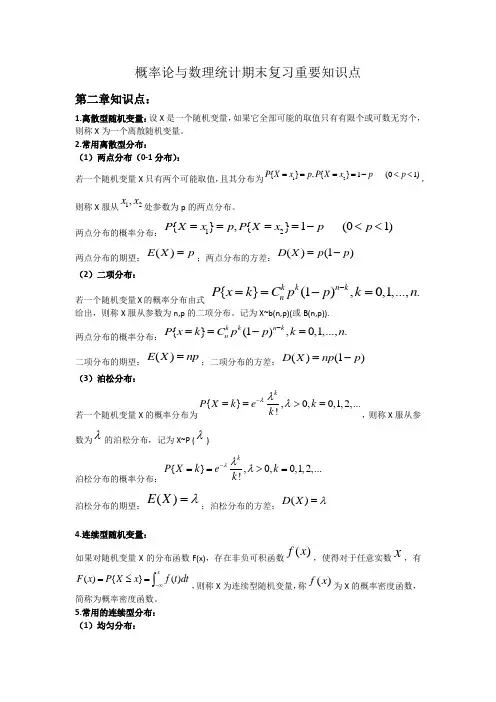
概率论与数理统计期末复习重要知识点第二章知识点:1.离散型随机变量:设X 是一个随机变量,如果它全部可能的取值只有有限个或可数无穷个,则称X 为一个离散随机变量。
2.常用离散型分布:(1)两点分布(0-1分布): 若一个随机变量X 只有两个可能取值,且其分布为12{},{}1(01)P X x p P X x p p ====-<<,则称X 服从12,x x 处参数为p 的两点分布。
两点分布的概率分布:12{},{}1(01)P X x p P X x pp ====-<<两点分布的期望:()E X p =;两点分布的方差:()(1)D X p p =-(2)二项分布:若一个随机变量X 的概率分布由式{}(1),0,1,...,.k kn k n P x k C p p k n -==-=给出,则称X 服从参数为n,p 的二项分布。
记为X~b(n,p)(或B(n,p)).两点分布的概率分布:{}(1),0,1,...,.k k n kn P x k C p p k n -==-= 二项分布的期望:()E X np =;二项分布的方差:()(1)D X np p =-(3)泊松分布:若一个随机变量X 的概率分布为{},0,0,1,2,...!kP X k ek k λλλ-==>=,则称X 服从参数为λ的泊松分布,记为X~P (λ)泊松分布的概率分布:{},0,0,1,2,...!kP X k ek k λλλ-==>=泊松分布的期望:()E X λ=;泊松分布的方差:()D X λ=4.连续型随机变量:如果对随机变量X 的分布函数F(x),存在非负可积函数()f x ,使得对于任意实数x ,有(){}()xF x P X x f t dt-∞=≤=⎰,则称X 为连续型随机变量,称()f x 为X 的概率密度函数,简称为概率密度函数。
5.常用的连续型分布: (1)均匀分布:若连续型随机变量X 的概率密度为⎪⎩⎪⎨⎧<<-=其它,0,1)(bx a a b x f ,则称X 在区间(a,b )上服从均匀分布,记为X~U(a,b)均匀分布的概率密度:⎪⎩⎪⎨⎧<<-=其它,0,1)(b x a a b x f 均匀分布的期望:()2a bE X +=;均匀分布的方差:2()()12b a D X -= (2)指数分布:若连续型随机变量X 的概率密度为00()0xe xf x λλλ-⎧>>=⎨⎩,则称X 服从参数为λ的指数分布,记为X~e (λ)指数分布的概率密度:00()0xe xf x λλλ-⎧>>=⎨⎩指数分布的期望:1()E X λ=;指数分布的方差:21()D X λ=(3)正态分布:若连续型随机变量X的概率密度为22()2()x f x x μσ--=-∞<<+∞则称X 服从参数为μ和2σ的正态分布,记为X~N(μ,2σ)正态分布的概率密度:22()2()x f x x μσ--=-∞<<+∞正态分布的期望:()E X μ=;正态分布的方差:2()D X σ=(4)标准正态分布:20,1μσ==,2222()()x t xx x e dtϕφ---∞=标准正态分布表的使用: (1)()1()x x x φφ<=--(2)~(0,1){}{}{}{}()()X N P a x b P a x b P a x b P a x b b a φφ<≤=≤≤=≤<=<<=-(3)2~(,),~(0,1),X X N Y N μμσσ-=故(){}{}()X x x F x P X x P μμμφσσσ---=≤=≤={}{}()()a b b a P a X b P Y μμμμφφσσσσ----<≤=≤≤=-定理1: 设X~N(μ,2σ),则~(0,1)X Y N μσ-=6.随机变量的分布函数: 设X 是一个随机变量,称(){}F x P X x =≤为X 的分布函数。

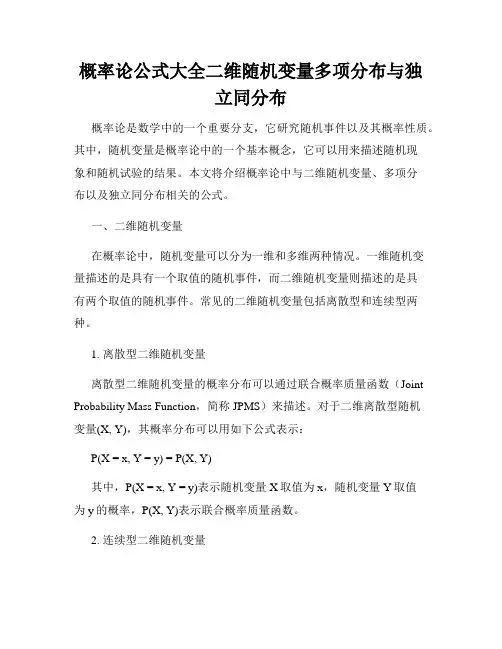
概率论公式大全二维随机变量多项分布与独立同分布概率论是数学中的一个重要分支,它研究随机事件以及其概率性质。
其中,随机变量是概率论中的一个基本概念,它可以用来描述随机现象和随机试验的结果。
本文将介绍概率论中与二维随机变量、多项分布以及独立同分布相关的公式。
一、二维随机变量在概率论中,随机变量可以分为一维和多维两种情况。
一维随机变量描述的是具有一个取值的随机事件,而二维随机变量则描述的是具有两个取值的随机事件。
常见的二维随机变量包括离散型和连续型两种。
1. 离散型二维随机变量离散型二维随机变量的概率分布可以通过联合概率质量函数(Joint Probability Mass Function,简称JPMS)来描述。
对于二维离散型随机变量(X, Y),其概率分布可以用如下公式表示:P(X = x, Y = y) = P(X, Y)其中,P(X = x, Y = y)表示随机变量X取值为x,随机变量Y取值为y的概率,P(X, Y)表示联合概率质量函数。
2. 连续型二维随机变量对于连续型二维随机变量,其概率分布则可以通过联合概率密度函数(Joint Probability Density Function,简称JPDS)来描述。
对于二维连续型随机变量(X, Y),其概率分布可以用如下公式表示:P(a ≤ X ≤ b, c ≤ Y ≤ d) = ∬f(x, y)dxdy其中,f(x, y)表示联合概率密度函数,∬表示对整个平面积分,a、b、c、d为常数。
二、多项分布多项分布是二项分布的推广,它适用于具有多个离散可能结果的试验。
假设有n个独立的试验,每个试验有k种可能的结果,且每种结果出现的概率是固定的。
那么多项分布描述了试验结果中每种可能出现的次数的概率分布。
多项分布的概率质量函数可以表示为:P(X₁ = x₁, X₂ = x₂, ..., Xk = xk) = (n! / (x₁! * x₂! * ... * xk!)) *(p₁^x₁ * p₂^x₂ * ... * pk^xk)其中,n为试验次数,xi表示结果i出现的次数,pi表示结果i出现的概率。
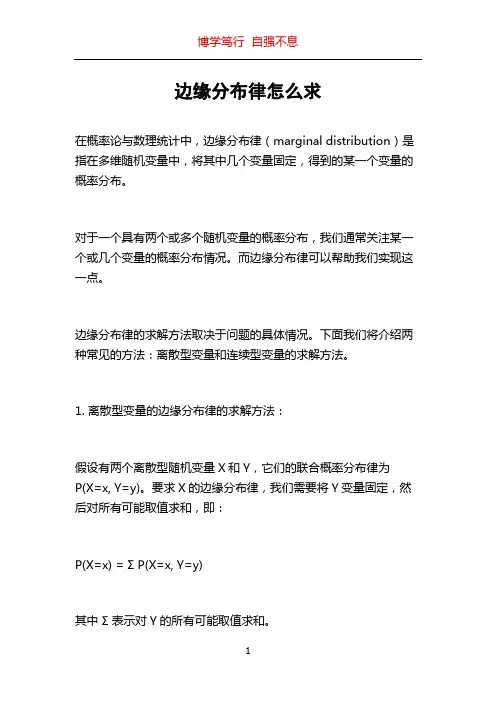
边缘分布律怎么求在概率论与数理统计中,边缘分布律(marginal distribution)是指在多维随机变量中,将其中几个变量固定,得到的某一个变量的概率分布。
对于一个具有两个或多个随机变量的概率分布,我们通常关注某一个或几个变量的概率分布情况。
而边缘分布律可以帮助我们实现这一点。
边缘分布律的求解方法取决于问题的具体情况。
下面我们将介绍两种常见的方法:离散型变量和连续型变量的求解方法。
1. 离散型变量的边缘分布律的求解方法:假设有两个离散型随机变量X和Y,它们的联合概率分布律为P(X=x, Y=y)。
要求X的边缘分布律,我们需要将Y变量固定,然后对所有可能取值求和,即:P(X=x) = Σ P(X=x, Y=y)其中Σ 表示对Y的所有可能取值求和。
2. 连续型变量的边缘分布律的求解方法:假设有两个连续型随机变量X和Y,它们的联合概率密度函数为f(x, y)。
要求X的边缘分布律,我们需要将Y变量固定,然后对X进行积分,即:fX(x) = ∫ f(x, y) dy其中∫ 表示对Y的所有取值进行积分。
需要注意的是,在求解边缘分布律时,我们需要考虑变量的范围。
如果X和Y的范围是有限的,那么在将变量固定时,需要限定积分或求和的范围。
此外,边缘分布律还可以通过累积分布函数(CDF)求得。
对于离散型变量,边缘分布律可以通过对联合分布函数求偏导得到。
对于连续型变量,边缘分布律可以通过对联合概率密度函数求偏导得到。
总之,边缘分布律是概率论与数理统计中的一个重要概念,可以帮助我们研究多维随机变量的概率分布。
根据变量的类型(离散型或连续型),我们可以选择不同的方法来求解边缘分布律。
无论是离散型还是连续型变量,求解边缘分布律都需要将其他变量固定,然后对概率分布进行求和或积分。
掌握求解边缘分布律的方法,对于我们研究随机变量的概率分布具有重要的意义。

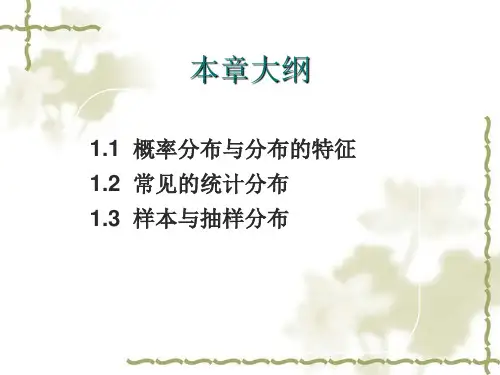
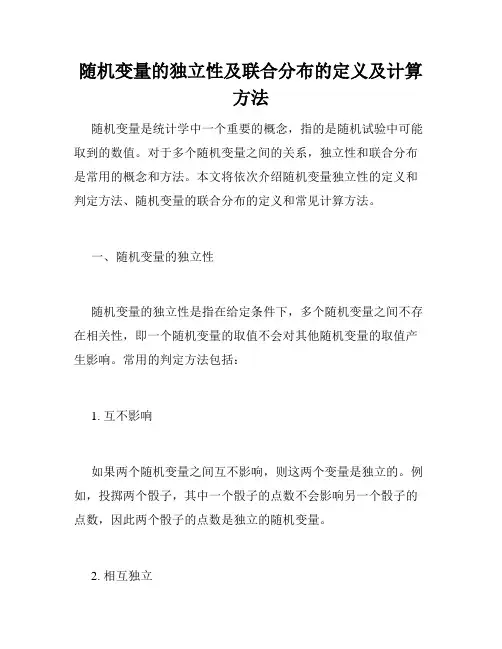
随机变量的独立性及联合分布的定义及计算方法随机变量是统计学中一个重要的概念,指的是随机试验中可能取到的数值。
对于多个随机变量之间的关系,独立性和联合分布是常用的概念和方法。
本文将依次介绍随机变量独立性的定义和判定方法、随机变量的联合分布的定义和常见计算方法。
一、随机变量的独立性随机变量的独立性是指在给定条件下,多个随机变量之间不存在相关性,即一个随机变量的取值不会对其他随机变量的取值产生影响。
常用的判定方法包括:1. 互不影响如果两个随机变量之间互不影响,则这两个变量是独立的。
例如,投掷两个骰子,其中一个骰子的点数不会影响另一个骰子的点数,因此两个骰子的点数是独立的随机变量。
2. 相互独立如果多个随机变量之间的任意两个变量都是独立的,则这些随机变量是相互独立的。
例如,投掷三个骰子,每个骰子的点数都是独立的随机变量,因此三个骰子的点数是相互独立的随机变量。
3. 独立性定义下的概率乘法公式对于两个独立的随机变量X和Y,它们同时取到某个值的概率等于它们各自取到这个值的概率的乘积。
即P(X=x,Y=y)=P(X=x)P(Y=y)。
该公式也适用于多个独立的随机变量。
二、随机变量的联合分布多个随机变量的联合分布是指这些随机变量取值组合所对应的概率分布函数。
常用的计算方法包括:1. 联合分布函数对于两个随机变量X和Y,它们的联合分布函数定义为F(x,y)=P(X<=x,Y<=y)。
该函数可以用来计算任意两个随机变量的联合分布。
对于多个随机变量,联合分布函数的定义相应地拓展。
2. 联合概率密度函数对于连续型随机变量,它们的联合概率密度函数可以通过对应的联合分布函数求导得到。
即f(x,y)=∂^2 F(x,y)/∂x∂y。
该函数可以用来计算任意两个连续型随机变量的联合分布。
对于多个连续型随机变量,联合概率密度函数的定义相应地拓展。
3. 边缘分布和条件分布对于联合分布中的任意一个随机变量,我们都可以将它的概率分布函数单独计算出来,称为边缘分布。


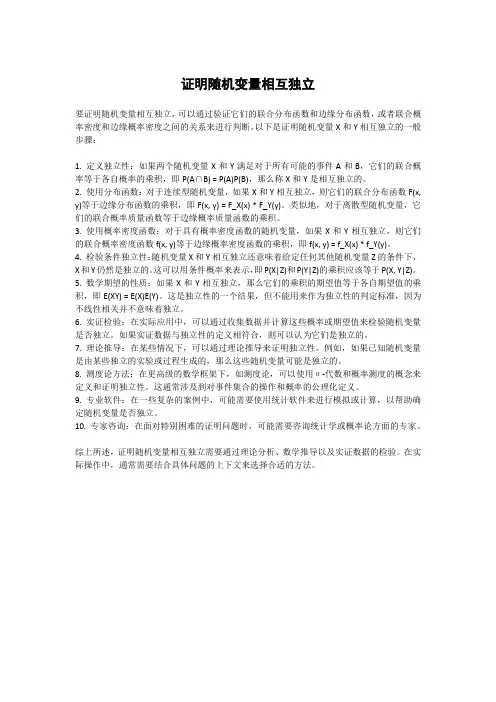
证明随机变量相互独立要证明随机变量相互独立,可以通过验证它们的联合分布函数和边缘分布函数,或者联合概率密度和边缘概率密度之间的关系来进行判断。
以下是证明随机变量X和Y相互独立的一般步骤:1. 定义独立性:如果两个随机变量X和Y满足对于所有可能的事件A和B,它们的联合概率等于各自概率的乘积,即P(A∩B) = P(A)P(B),那么称X和Y是相互独立的。
2. 使用分布函数:对于连续型随机变量,如果X和Y相互独立,则它们的联合分布函数F(x, y)等于边缘分布函数的乘积,即F(x, y) = F_X(x) * F_Y(y)。
类似地,对于离散型随机变量,它们的联合概率质量函数等于边缘概率质量函数的乘积。
3. 使用概率密度函数:对于具有概率密度函数的随机变量,如果X和Y相互独立,则它们的联合概率密度函数f(x, y)等于边缘概率密度函数的乘积,即f(x, y) = f_X(x) * f_Y(y)。
4. 检验条件独立性:随机变量X和Y相互独立还意味着给定任何其他随机变量Z的条件下,X和Y仍然是独立的。
这可以用条件概率来表示,即P(X|Z)和P(Y|Z)的乘积应该等于P(X, Y|Z)。
5. 数学期望的性质:如果X和Y相互独立,那么它们的乘积的期望值等于各自期望值的乘积,即E(XY) = E(X)E(Y)。
这是独立性的一个结果,但不能用来作为独立性的判定标准,因为不线性相关并不意味着独立。
6. 实证检验:在实际应用中,可以通过收集数据并计算这些概率或期望值来检验随机变量是否独立。
如果实证数据与独立性的定义相符合,则可以认为它们是独立的。
7. 理论推导:在某些情况下,可以通过理论推导来证明独立性。
例如,如果已知随机变量是由某些独立的实验或过程生成的,那么这些随机变量可能是独立的。
8. 测度论方法:在更高级的数学框架下,如测度论,可以使用σ-代数和概率测度的概念来定义和证明独立性。
这通常涉及到对事件集合的操作和概率的公理化定义。
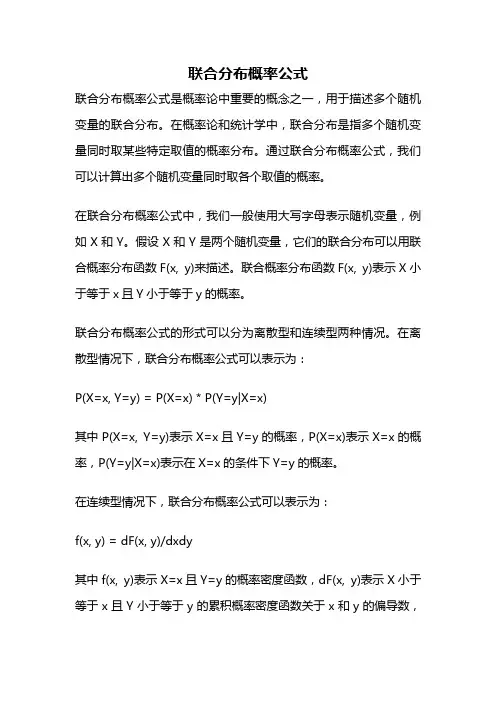
联合分布概率公式联合分布概率公式是概率论中重要的概念之一,用于描述多个随机变量的联合分布。
在概率论和统计学中,联合分布是指多个随机变量同时取某些特定取值的概率分布。
通过联合分布概率公式,我们可以计算出多个随机变量同时取各个取值的概率。
在联合分布概率公式中,我们一般使用大写字母表示随机变量,例如X和Y。
假设X和Y是两个随机变量,它们的联合分布可以用联合概率分布函数F(x, y)来描述。
联合概率分布函数F(x, y)表示X小于等于x且Y小于等于y的概率。
联合分布概率公式的形式可以分为离散型和连续型两种情况。
在离散型情况下,联合分布概率公式可以表示为:P(X=x, Y=y) = P(X=x) * P(Y=y|X=x)其中P(X=x, Y=y)表示X=x且Y=y的概率,P(X=x)表示X=x的概率,P(Y=y|X=x)表示在X=x的条件下Y=y的概率。
在连续型情况下,联合分布概率公式可以表示为:f(x, y) = dF(x, y)/dxdy其中f(x, y)表示X=x且Y=y的概率密度函数,dF(x, y)表示X小于等于x且Y小于等于y的累积概率密度函数关于x和y的偏导数,dxdy表示对x和y的微元积分。
通过联合分布概率公式,我们可以计算出多个随机变量的联合概率分布。
这对于理解随机变量之间的关系和进行概率推断具有重要意义。
例如,在金融领域中,我们可以使用联合分布概率公式来计算不同证券之间的相关性,从而进行投资组合的优化。
在医学领域中,我们可以使用联合分布概率公式来分析疾病的风险因素和预测患病概率。
除了计算联合概率分布,联合分布概率公式还可以用于计算随机变量的边缘概率分布和条件概率分布。
边缘概率分布是指在多个随机变量的联合分布已知的情况下,计算某个随机变量的概率分布。
条件概率分布是指在某个随机变量的取值已知的情况下,计算其他随机变量的概率分布。
联合分布概率公式是概率论中重要的工具之一,用于描述多个随机变量的联合分布。
概率论与数理统计总结之第四章第四章概率论与数理统计总结第四章是概率论与数理统计中的重要章节,主要介绍了概率分布以及随机变量的性质和应用。
本章内容相对较为复杂,需要掌握一定的数学基础知识,但是只要我们认真学习并进行实践,就能够掌握其中的核心概念和方法。
本章的重点内容包括:离散型随机变量及其概率分布、连续型随机变量及其概率密度函数、随机变量的函数分布、两个随机变量的联合分布、随机变量的独立性等。
首先,我们需要了解离散型随机变量及其概率分布。
离散型随机变量是一种取有限或可数个数值的随机变量,其概率分布可以通过概率分布列或概率质量函数进行描述。
常见的离散型随机变量有二项分布、泊松分布等。
我们需要掌握这些分布的定义、性质以及应用,能够计算其均值、方差以及分布函数等。
接着,我们学习了连续型随机变量及其概率密度函数。
连续型随机变量是一种取连续数值的随机变量,其概率分布可以通过概率密度函数进行描述。
常见的连续型随机变量有均匀分布、正态分布等。
我们需要了解这些分布的定义、性质以及应用,能够计算其期望、方差以及分位数等。
随后,我们学习了随机变量的函数分布。
通过对随机变量进行函数变换,可以得到新的随机变量,其概率分布可以通过原始随机变量的概率分布进行推导。
我们需要了解函数分布的计算方法,能够根据随机变量的分布函数和概率密度函数计算新的随机变量的分布函数和概率密度函数。
然后,我们学习了两个随机变量的联合分布。
对于两个随机变量,我们可以通过联合分布来描述它们的联合概率分布。
对于离散型随机变量,我们可以通过联合分布列来描述;对于连续型随机变量,我们可以通过联合概率密度函数来描述。
我们需要掌握联合概率分布的计算方法,能够计算两个随机变量的联合概率、边缘概率以及条件概率等。
最后,我们学习了随机变量的独立性。
当两个随机变量的联合概率分布可以通过各自的边缘概率分布表示时,我们称它们是独立的。
我们需要了解独立性的定义和性质,能够判断两个随机变量是否独立,并能够计算独立随机变量的联合概率分布。
欢迎共阅概率论知识点总结第一章随机事件及其概率第一节基本概念随机实验:将一切具有下面三个特点:(1)可重复性(2)多结果性(3)不确定性的试验或观察称为随机试验,简称为试验,常用E 表示。
随机事件:在一次试验中,可能出现也可能不出现的事情(结果)称为随机事件,简称为事件。
不可能事件:在试验中不可能出现的事情,记为Ф。
必然事件样本点样本空间包含关系相等关系事件的和记为A ∪事件的积事件的差互斥事件对立事件=⋂B A (1(2(3)分配律:A ∪(B∩C)=(A ∪B)∩(A ∪C)A(B ∪C)=(A∩B)∪(A∩C)=AB ∪AC(4)对偶律(摩根律):B A B A ⋂=⋃B A B A ⋃=⋂第二节事件的概率概率的公理化体系:(1)非负性:P(A)≥0;(2)规范性:P(Ω)=1(3)可数可加性: ⋃⋃⋃⋃n A A A 21两两不相容时概率的性质:(1)P(Φ)=0(2)有限可加性:n A A A ⋃⋃⋃ 21两两不相容时当AB=Φ时P(A ∪B)=P(A)+P(B)(3))(1)(A P A P -=(4)P(A -B)=P(A)-P(AB)(5)P (A ∪B )=P(A)+P(B)-P(AB)第三节古典概率模型1、设试验E 是古典概型,其样本空间Ω由n 个样本点组成,事件A 由k 个样本点组成.则定义事件A的概率为2落在区域把μ. ,,则称A 、总结:1.3.第二章一维随机变量及其分布第二节分布函数分布函数:设X 是一个随机变量,x 为一个任意实数,称函数}{)(x X P x F ≤=为X 的分布函数。
如果将X 看作数轴上随机点的坐标,那么分布函数F(x)的值就表示X 落在区间],(x -∞内的概率 分布函数的性质:(1)单调不减;(2)右连续;(3)1)(,0)(=+∞=-∞F F第三节离散型随机变量离散型随机变量的分布律:设k x (k=1,2,…)是离散型随机变量X 所取的一切可能值,称k k p x X P ==}{为离散型随机变量X 的分布律,也称概率分布.当离散性随机变量取值有限且概率的规律不明显时,常用表格形式表示分布律。
离散和连续的联合分布例子离散和连续的联合分布是概率论中一个重要的概念,它用于描述两个变量之间的关系。
以下是一个例子,用离散和连续的联合分布来分析一个问题。
假设有一个工厂生产零件,每天生产的数量是一随机变量X,它的取值范围为1到10,且每个取值的概率分别为0.1,0.15,0.2,0.25,0.1,0.05,0.05,0.04,0.03,0.03。
另外,假设每天生产的零件质量也是一个随机变量Y,它的概率密度函数为f(y)=2y,其中y的取值范围为0到2。
现在我们想要找出每天生产的零件数量和零件质量之间的关系。
我们可以定义一个联合随机变量Z=(X,Y),Z的取值范围是所有可能的(X,Y)对,我们可以列出其联合概率分布表如下:| X/Y | 0 | 0.25 | 0.5 | 0.75 | 1 | 1.25 | 1.5 | 1.75 | 2 || --- | --- | --- | --- | --- | --- | --- | --- | --- | --- || 1 | 0 | 0 | 0 | 0 | 0.02 | 0.025 | 0.03 | 0.035 |0.04 || 2 | 0 | 0 | 0 | 0.0125 | 0.03 | 0.0375 | 0.045 |0.0525 | 0.06 || 3 | 0 | 0 | 0.01 | 0.0375 | 0.06 | 0.075 | 0.09 |0.105 | 0.12 || 4 | 0 | 0.0075 | 0.03 | 0.0675 | 0.1 | 0.125 | 0.15 | 0.175 | 0.2 || 5 | 0.01 | 0.0225 | 0.045 | 0.0775 | 0.11 | 0.1375 | 0.165 | 0.1925 | 0.22 || 6 | 0.015 | 0.0375 | 0.06 | 0.0925 | 0.125 | 0.1575 | 0.19 | 0.2225 | 0.255 || 7 | 0.02 | 0.0525 | 0.075 | 0.1075 | 0.14 | 0.1775 | 0.215 | 0.2525 | 0.29 || 8 | 0.02 | 0.0675 | 0.09 | 0.1225 | 0.155 | 0.1975 | 0.24 | 0.2825 | 0.325 || 9 | 0.02 | 0.0825 | 0.105 | 0.1375 | 0.17 | 0.2175 | 0.265 | 0.3125 | 0.36 || 10 | 0.03 | 0.0975 | 0.12 | 0.1525 | 0.185 | 0.2375 | 0.29 | 0.3425 | 0.395 |从表中可以看出,在生产的零件数量比较小的时候,零件的质量比较集中,而在生产的零件数量比较大的时候,零件的质量分布比较广。
离散和连续的联合概率密度离散和连续的联合概率密度在统计学中非常关键。
这些概率密度函数通常用于描述两个或多个随机变量之间的关系,以及它们如何共同影响事件的发生。
离散和连续的联合概率密度函数在许多领域都有广泛应用,例如金融、工程、物理、生物学和医学等领域。
在统计学中,离散和连续的联合概率密度函数定义了两个或多个随机变量同时取某些特定值的概率。
对于离散随机变量,其概率密度函数是由一系列可能取值及其对应概率值组成的表格。
不同离散随机变量的联合概率密度函数也可以用类似的表格方式表示。
而对于连续随机变量,其联合概率密度函数是一个二维函数,它表示两个连续随机变量同时取某个区域的概率。
这个函数通常用一个平面图形来表示。
离散和连续的联合概率密度函数都具有重要的统计学意义。
由于一个事件的发生往往涉及到多个因素,因此联合概率密度函数的分析可以更好地捕捉随机过程中的关联性和复杂性。
在金融领域,联合概率密度函数可以用于估计多个资产价格的风险和投资组合的回报率。
这些函数还可以用于物理学家研究原子和分子间的相互作用,以及生物学家研究基因之间的互动机制。
对于离散和连续的联合概率密度函数,我们可以计算各种概率、期望值和方差等统计量。
令X和Y是两个随机变量,它们的联合概率密度函数为f(x,y)。
则X和Y的边缘概率密度函数可以分别表示为f1(x)=∑yf(x,y)与f2(y)=∫xf(x,y)dy。
同时,我们还可以计算出X和Y 的协方差,其公式为cov(X,Y)=E[(X-μX)(Y-μY)],其中μX和μY分别是X和Y的均值。
协方差描述的是两个随机变量之间线性相关程度的一个度量,它的值越接近于零,则说明两个变量之间的关联性越小。
综上所述,离散和连续的联合概率密度函数是现代统计学中非常有用的工具。
通过对这些函数的分析,我们可以更好地了解随机过程中的复杂性和关联性,为各种学科的研究提供基础支持。
联合分布(⼆):联合分布
在概率论中,对两个随机变量X和Y,其联合分布是同时对于X和Y的概率分布(关于概率分布的理论请参考:)。
乍⼀看:“同时对于X和Y的概率分布”,感觉很懵,不懂是啥意思。
没关系,我们带着这个疑问,继续往下看:
联合分布可以划分为两种,⼀种是关于离散随机变量的联合分布,另⼀种是关于连续随机变量的。
1)离散随机变量的联合分布:
对离散随机变量⽽⾔,联合分布概率函数为P(X = x & Y = y),即
P(X=x\;\mathrm{and}\;Y=y)\;=\;P(Y=y|X=x)P(X=x)= P(X=x|Y=y)P(Y=y).\;
仔细看看这个公式,其实就是X和Y同时发⽣的⼀个概率函数,那么它的(联合)分布函数是怎样的呢?在上⼀篇我们说到,分布函数就是概率函数的累加嘛。
类似的,联合分布函数:
可能光看公式很难理解,我们结合⼀个例⼦来看看
连续抛五次硬币,设:X: 最后两次出现反⾯的次数,可以取值0,1,2;Y: 投掷为正⾯的总数,可以取值0,1,2,3,4,5;
把这两个随机变量的联合分布⼀⼀列出来给⼤家看看:
那么F(1,2)=p11+p12,F(2,3)=p11+p12+p13+p23,
这样表⽰的话,你该明⽩了吧。
就本质上来说,离散联合分布依然概率值的累加,但是这个概率值已经变成两个事件同时发⽣的概率值了
2)连续随机变量的联合分布:
设X和Y的联合概率密度函数为f(x,y),那么X和Y的联合分布函数为:
未完待续。
离散和连续的联合分布例子
离散和连续的联合分布可以用于描述两个或多个随机变量之间的关系。
举个例子,考虑一个人在一天中既可以花费一定的时间阅读书籍,也可以花费一定的时间看电视。
假设这个人有50%的概率选择阅读书籍,50%的概率选择看电视。
如果选择阅读书籍,他会在1小时内完成。
如果选择看电视,他会花费1-3小时的时间,每个小时的概率相同。
我们可以使用两个随机变量来描述这个情境:X代表这个人看电视所花费的时间,Y代表他阅读书籍所花费的时间。
由于选择阅读书籍的概率是50%,所以X和Y的联合分布可以表示为:P(X=x,Y=y) = 0.5 * δ(y-1) + 0.5 * f(x,y)
其中δ(y-1)表示y=1的概率为1,f(x,y)表示X和Y的联合密度函数,即:
f(x,y) = 0.25,当1≤y≤4,0≤x≤1
0,其他情况
这个联合分布中既有离散的部分(δ(y-1)),又有连续的部分(f(x,y))。
我们可以使用这个联合分布来计算这个人花费时间的期望值或方差等统计量,从而更好地理解这个情境的性质和特点。
- 1 -。
Joint Distributions,Discrete CaseIn the following,X and Y are discrete random variables.1.Joint distribution(joint p.m.f.):•Definition:f(x,y)=P(X=x,Y=y)•Properties:(1)f(x,y)≥0,(2)x,yf(x,y)=1•Representation:The most natural representation of a joint discrete distribution is asa distribution matrix,with rows and columns indexed by x and y,and the xy-entrybeing f(x,y).This is analogous to the representation of ordinary discrete distributionsas a single-row table.As in the one-dimensional case,the entries in a distribution matrixmust be nonnegative and add up to1.2.Marginal distributions:The distributions of X and Y,when considered separately.•Definition:•f X(x)=P(X=x)=yf(x,y)•f Y(y)=P(Y=y)=xf(x,y)•Connection with distribution matrix:The marginal distributions f X(x)and f Y(y)can be obtained from the distribution matrix as the row sums and column sums of theentries.These sums can be entered in the“margins”of the matrix as an additionalcolumn and row.•Expectation and variance:µX,µY,σ2X ,σ2Ydenote the(ordinary)expectations andvariances of X and Y,computed as usual:µX=xxf X(x),etc.putations with joint distributions:•Probabilities:Probabilities involving X and Y(e.g.,P(X+Y=3)or P(X≥Y)can be computed by adding up the corresponding entries in the distribution matrix:More formally,for any set R of points in the xy-plane,P((X,Y)∈R))=(x,y)∈Rf(x,y).•Expectation of a function of X and Y(e.g.,u(x,y)=xy):E(u(X,Y))=x,yu(x,y)f(x,y).This formula can also be used to compute expectation and variance of the marginal distributions directly from the joint distribution,withoutfirst computing the marginal distribution.For example,E(X)=x,yxf(x,y).4.Covariance and correlation:•Definitions:Cov(X,Y)=E(XY)−E(X)E(Y)=E((X−µX)(Y−µY))(Covarianceof X and Y),ρ=ρ(X,Y)=Cov(X,Y)σXσY(Correlation of X and Y)•Properties:|Cov(X,Y)|≤σXσY,−1≤ρ(X,Y)≤1•Relation to variance:Var(X)=Cov(X,X)•Variance of a sum:Var(X+Y)=Var(X)+Var(Y)+2Cov(X,Y)(Note the analogy of the latter formula to the identity(a+b)2=a2+b2+2ab;the covariance acts like a “mixed term”in the expansion of Var(X+Y).)15.Independence of random variables:•Definition:X and Y are called independent if the joint p.m.f.is the product of the individual p.m.f.’s:i.e.,if f(x,y)=f X(x)f Y(y)for all values of x and y.•Properties of independent random variables:If X and Y are independent,then:–The expectation of the product of X and Y is the product of the individual expectations:E(XY)=E(X)E(Y).More generally,this product formula holdsfor any expectation of a function X times a function of Y.For example,E(X2Y3)=E(X2)E(Y3).–The product formula holds for probabilities of the form P(some condi-tion on X,some condition on Y)(where the comma denotes“and”):Forexample,P(X≤2,Y≤3)=P(X≤2)P(Y≤3).–The covariance and correlation of X and Y are0:Cov(X,Y)=0,ρ(X,Y)=0.–The variance of the sum of X and Y is the sum of the individual variances: Var(X+Y)=Var(X)+Var(Y)–The moment-generating function of the sum of X and Y is the product of the individual moment-generating functions:M X+Y(t)=M X(t)M Y(t).(Note that it is the sum X+Y,not the product XY,which has this property.) 6.Conditional distributions:•Definitions:–conditional distribution(p.m.f.)of X given that Y=y:g(x|y)=P(X=x|Y=y)=f(x,y)f Y(y)–conditional distribution(p.m.f.)of Y given that X=x:h(y|x)=P(Y=y|X=x)=f(x,y)f X(x)•Connection with distribution matrix:Conditional distributions are the distribu-tions obtained byfixing a row or column in the matrix and rescaling the entries in that row or column so that they again add up to1.For example,h(y|2),the conditional dis-tribution of Y given that X=2,is the distribution given by the entries in row2of the matrix,rescaled by dividing by the row sum(namely,f X(2)):h(y|2)=f(2,y)/f X(2).•Conditional expectations and variance:Conditional expectations,variances,etc., are defined and computed as usual,but with conditional distributions in place of ordinary distributions:•E(X|y)=E(X|Y=y)=xg(x|y)xx2g(x|y)•E(X2|y)=E(X2|Y=y)=x•Var(X|y)=Var(X|Y=y)=E(X2|y)−E(X|y)2More generally,for any condition(such as Y>0),the expectation of X given this condition is defined as•E(X|condition)=xP(X=x|condition)xand can be computed by starting out with the usual formula for the expectation,but restricting to those terms that satisfy the condition.2Joint Distributions,Continuous CaseIn the following,X and Y are continuous random variables.Most of the concepts and formulas below are analogous to those for the discrete case,with integrals replacing sums.The principal difference between continuous lies in the definition of the p.d.f./p.m.f.f (x,y ):The formula f (x,y )=P (X =x,Y =y )is no longer valid,and there is no simple and direct way to obtain f (x,y )from X and Y .1.Joint continuous distributions:•Joint density (joint p.d.f.):A function f (x,y )satisfying (i)f (x,y )≥0,(ii) f (x,y )dxdy =ually,f (x,y )will be given by an explicit formula,along with a range (a region in the xy -plane)on which this formula holds.In the general formulas below,if a range of integration is not explicitly given,the integrals are to be taken over the range in which the density function is defined.•Uniform joint distribution:An important special type of joint density is one that is constant over a given range (a region in the xy -plane),and 0outside outside this range,the constant being the reciprocal of the area of of the range.This is analogous to the concept of an ordinary (one-variable)uniform density f (x )over an interval I ,which is constant (and equal to the reciprocal of the length of I )inside the interval,and 0outside it.2.Marginal distributions:The ordinary distributions of X and Y ,when considered sepa-rately.The corresponding (one-variable)densities are denoted by f X (or f 1)and f Y (or f 2),and obtained by integrating the joint density f (x,y )over the “other”variable:f X (x )= f (x,y )dy,f Y (y )= f (x,y )dx.putations with joint distributions:•Probabilities:Given a region R in the xy -plane the probability that (X,Y )falls into this region is given by the double integral of f (x,y )over this region.For example,P (X +Y ≤1)is given by an integral of the form R f (x,y )dxdy ,where R consists of the part of the range of f in which x +y ≤1.•Expectation of a function of X and Y (e.g.,u (x,y )=xy ):E (u (X,Y ))= u (x,y )f (x,y )dxdy4.Covariance and correlation:The formulas and definitions are the same as in the discrete case.•Definitions:Cov(X,Y )=E (XY )−E (X )E (Y )=E ((X −µX )(Y −µY ))(Covarianceof X and Y ),ρ=ρ(X,Y )=Cov(X,Y )σX σY(Correlation of X and Y )•Properties:|Cov(X,Y )|≤σX σY ,−1≤ρ(X,Y )≤1•Relation to variance:Var(X )=Cov(X,X )•Variance of a sum:Var(X +Y )=Var(X )+Var(Y )+2Cov(X,Y )5.Independence of random variables:Same as in the discrete case:•Definition:X and Y are called independent if the joint p.d.f.is the product of the individual p.d.f.’s:i.e.,if f (x,y )=f X (x )f Y (y )for all x ,y .3•Properties of independent random variables:If X and Y are independent,then:–The expectation of the product of X and Y is the product of the individual expectations:E(XY)=E(X)E(Y).More generally,this product formula holdsfor any expectation of a function X times a function of Y.For example,E(X2Y3)=E(X2)E(Y3).–The product formula holds for probabilities of the form P(some condi-tion on X,some condition on Y)(where the comma denotes“and”):Forexample,P(X≤2,Y≤3)=P(X≤2)P(Y≤3).–The covariance and correlation of X and Y are0:Cov(X,Y)=0,ρ(X,Y)=0.–The variance of the sum of X and Y is the sum of the individual variances: Var(X+Y)=Var(X)+Var(Y)–The moment-generating function of the sum of X and Y is the product of the individual moment-generating functions:M X+Y(t)=M X(t)M Y(t).6.Conditional distributions:Same as in the discrete case,with integrals in place of sums:•Definitions:–conditional density of X given that Y=y:g(x|y)=f(x,y)f Y(y)–conditional density of Y given that X=x:h(y|x)=f(x,y)f X(x)•Conditional expectations and variance:Conditional expectations,variances,etc., are defined and computed as usual,but with conditional distributions in place of ordinarydistributions.For example:•E(X|Y=1)=E(X|Y=1)=xg(x|1)dx•E(X2|Y=1)=E(X2|Y=1)=x2g(x|1)dx 4。